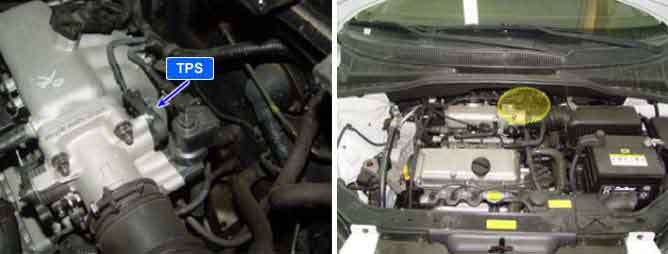

The Throttle Position Sensor (TPS) is mounted on the throttle body and detects the opening angle of the throttle plate.
The TPS has a variable resistor (potentiometer) whose characteristic is the resistance changing according to the throttle angle. During acceleration, the TPS resistance between the reference 5V and the signal terminal decreases and output voltage increases; during deceleration, the TPS resistance increases and TPS output voltage decreases.
The ECM supplies a reference 5V to the TPS and the output voltage increases directly with the opening of the throttle valve. The TPS output voltage will vary from 0.2~0.8V at closed throttle to 4.3~4.8V at wide-open throttle.
The ECM determines operating conditions such as idle (closed throttle), part load, acceleration/deceleration, and wide-open throttle from the TPS. Also The ECM uses the Mass Air Flow Sensor (MAFS) or Manifold Absolute Pressure Sensor (MAPS) signal along with the TPS signal to adjust fuel injection duration and ignition timing.
If the number that throttle angle input signal chages rapidly (above 30%) is 3 times or more, PCM sets DTC P0121.
Item | Detecting Condition | Possible Cause |
DTC Strategy | ● Rationality check (Jittering) | ● Poor connection ● TPS ● ECM |
Enable Conditions | ● Engine speed > 600 rpm | |
Threshold Value | ● Counter of ㅣ△ throttle angle > 30%ㅣ≥ 3 times | |
Diagnostic Time | ||
MIL ON Condition | ● 3 driving cycle |
ITEM | Specification |
TPS Resistance (㏀) | 2㏀ ± 20% (20℃) |
